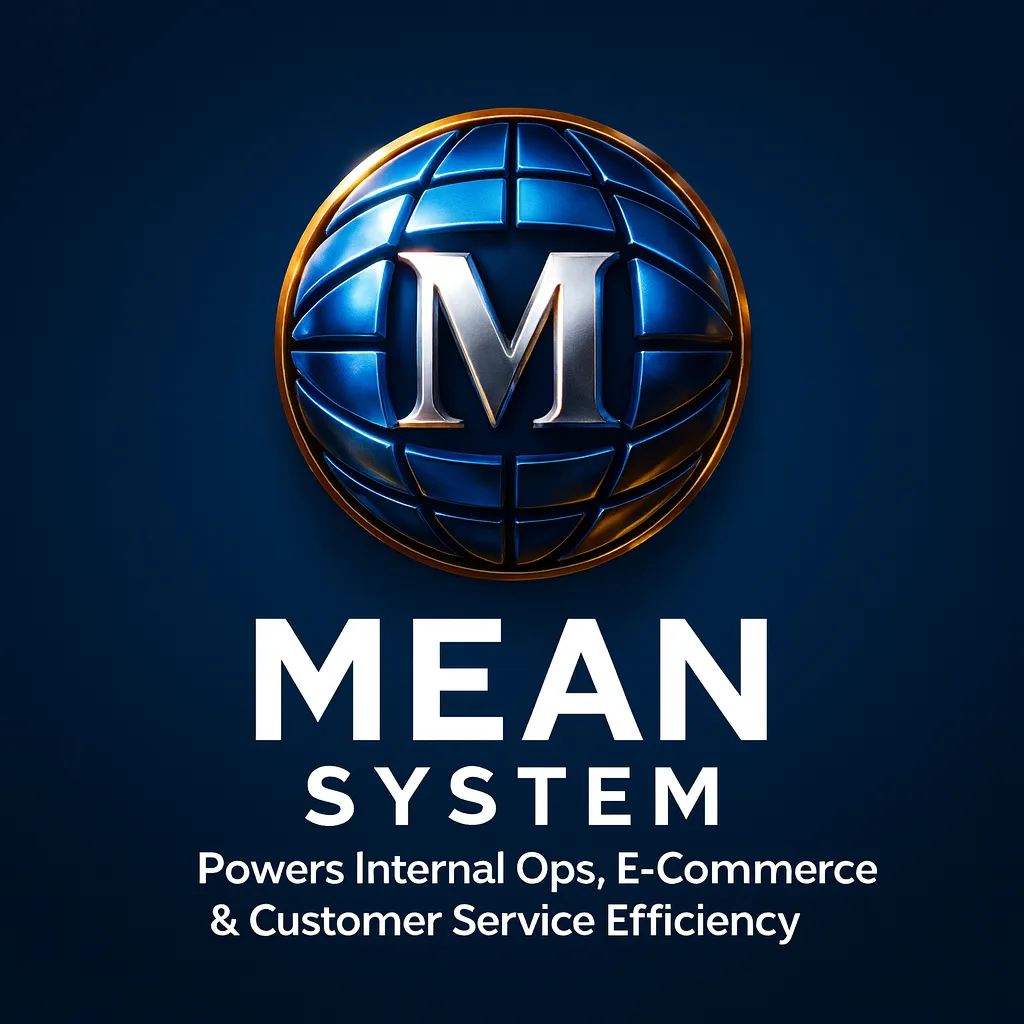
How the MEAN System Powers Internal Ops, E-Commerce & Customer Service Efficiency
How the MEAN System Powers Internal Ops, E-Commerce & Customer Service Efficiency
MEAN unifies teams, data, and automation in one system.
Most teams don’t struggle because they lack tools. They struggle because those tools don’t talk to each other. Marketing runs campaigns, sales chases leads, operations manages orders and inventory, and customer service fights fires—often in separate systems. The result is slow handoffs, duplicate work, and missed revenue.
The MEAN System changes that. It’s more than a marketing platform. It’s an all-in-one business system and a true business automation system that centralizes operations, e-commerce workflows, and customer service so your teams work from the same playbook. When data is unified and automation runs across departments, you save time, reduce errors, and scale with confidence.
What you’ll learn
Where disconnected tools cost you time and money
How MEAN centralizes data and automates internal operations
How e-commerce workflow automation boosts conversion, AOV, and retention
How customer service automation improves response times and CSAT
A practical 90-day rollout plan and real-world examples
What the MEAN System Is (and Why It Matters Now)
The MEAN System is an integrated business automation system designed to unify:
Internal operations automation: tasks, approvals, scheduling, inventory signals, finance handoffs
E-commerce workflow automation: product sync, orders, fulfillment, returns, payments, loyalty
Customer service automation: omnichannel support, triage, knowledge base, SLA and CSAT tracking
Marketing and communications: lifecycle messaging, ads, attribution, segmentation
Instead of stitching together separate tools, MEAN provides a shared customer and order timeline, a cross-functional workflow engine, and role-based dashboards. That means a customer’s ad click, cart event, order, ticket, and renewal live in one place—and automations can react to any of those signals instantly.
The Hidden Tax of Fragmentation
Context switching: Staff lose hours every week bouncing between systems to piece together a story.
Data silos: Marketing can’t see fulfillment delays; support can’t see campaign promises; ops can’t see VIP segments.
Manual glue: CSV exports, copy/paste between apps, and “did you see this?” Slack threads create errors.
Slow response: Customers wait; carts get abandoned; returns drag; renewals slip.
When a single platform coordinates the flow, your team works faster and customers feel it.
How MEAN Centralizes Your Business
Unified data layer: Contacts, companies, products, carts, orders, subscriptions, tickets, and conversations live in one system.
Cross-channel timeline: Every touch—ad, email, chat, call, order, shipment, review—is connected to the same record.
Workflow engine: No-code automations and branching logic across events and systems (internal and external).
Role-based views: Each team sees what matters—finance sees invoices; ops sees orders and SLAs; service sees priority tickets.
Governance: Permissions, approvals, audit logs, and templates ensure consistency and control.
Internal Operations Automation: From “Chasing Tasks” to “System-Driven”
What it does for ops
Automates handoffs between sales, finance, and fulfillment
Coordinates approvals (discounts, purchase orders, refunds) with timestamps and auditability
Standardizes recurring processes—onboarding, vendor management, monthly reporting
Triggers alerts when thresholds are crossed (inventory low, late shipment, overdue invoice)
Centralizes scheduling and assignments for field teams or service appointments
Common automations you can enable
Lead-to-order handoff: When a quote is accepted, automatically generate an order, assign fulfillment, and notify finance.
Purchase order approvals: If product inventory dips below X, create a PO draft, route to manager for approval, and notify vendor.
Billing and collections: Generate invoices on order completion; follow up with smart reminders; escalate at set intervals.
Internal SLA alerts: If a task or ticket nears its SLA, notify the owner, escalate to a manager, and update the dashboard status.
Compliance and documentation: Apply required disclaimers and attach checklists before a workflow advances.

Automated purchase order approvals keep inventory flowing without manual chasing.
Playbook: Automate a purchase order approval
Trigger: Inventory falls below threshold for a SKU or bundle.
Action: Create a PO record populated with vendor, pricing tiers, and quantities.
Approval path: Route to manager; if value > $5,000, add finance approver.
Notifications: Slack/email to approvers with clickable approve/deny actions.
Post-approval: Send PO to vendor, create expected delivery tasks, and adjust reorder flags.
Reporting: Log approval timestamps for cycle-time dashboards.
E‑Commerce Workflow Automation: From Click to Repeat Purchase
A robust all-in-one business system shouldn’t replace your store platform; it should orchestrate it. MEAN integrates with platforms like Shopify or WooCommerce and payment providers like Stripe, then automates the lifecycle end-to-end.

The e‑commerce lifecycle, automated—from cart recovery to replenishment and loyalty.
Key e‑commerce workflows
Cart and browse recovery: Detect cart events and browsing behavior; send timely, personalized recovery sequences.
Order routing and fulfillment: Assign orders by warehouse/region; create pick/pack tasks; push shipping updates to customers.
Post-purchase flows: Trigger cross-sells, setup instructions, and review requests tailored by product and AOV.
Returns and exchanges: Offer self-service returns; auto-issue labels; update inventory and notify finance.
Subscription management: Proactive dunning, swap/skip options, replenishment reminders based on usage patterns.
Loyalty and referrals: Award points on events; invite referrals post-delivery; segment VIPs for early access drops.
Playbook: From add-to-cart to repeat purchase
Trigger: Add-to-cart event with product tags (e.g., “consumable”).
Recovery: If no purchase in 1 hour, send benefit-led reminder; include social proof or an FAQ that removes friction.
Conversion support: If the customer replies via SMS or chat, route to an agent with the cart visible in the timeline.
Post-purchase: On first order, send “getting started” guide, warranty registration, and an upsell tailored to the item.
Replenishment: Based on average consumption, schedule a reminder at 21–28 days with 1-click reorder.
Loyalty and reviews: After delivery, request a review; if positive, invite a referral. If negative, auto-create a ticket and escalate.
Customer Service Automation: Faster Responses, Higher CSAT
Customer service automation isn’t just chatbots. It’s intelligent routing, self-service where it helps, and human expertise where it counts.

Give agents one thread across email, SMS, chat, and social with live order context.
What MEAN enables
Omnichannel inbox: Email, SMS, chat, social comments, and phone logs in one thread tied to the customer’s profile and order history.
Smart triage: Classify intent (billing, shipping, product help), route to the right queue, and set SLA by priority.
Self-service flows: Authenticated order lookup, returns initiation, delivery status, and FAQs without agent involvement.
Knowledge base and agents: Surface relevant articles to both customers and agents; measure deflection and article usefulness.
Proactive alerts: Notify customers of delays or backorders before they ask; offer alternatives and discounts automatically.
CSAT and NPS: Trigger surveys after interactions; close the loop when scores are low with a follow-up workflow.
Playbook: First-response automation with human handoff
Trigger: New inbound message detected as “Where’s my order?”
Bot assist: Authenticate the customer, display live shipment status, and offer options (expedite, refund, replacement).
Human handoff: If the customer requests an exception, route to a senior agent with the order timeline and prior interactions.
SLA control: If no agent reply within 10 minutes, escalate to a manager and notify the customer of the expected response time.
Close the loop: After resolution, trigger a CSAT survey and note outcomes for trend analysis.
Real-World Impact: Three Quick Examples
Boutique DTC brand boosts repeat orders
Challenge: High cart abandonment, inconsistent post-purchase communication.
Solution: MEAN’s e-commerce workflow automation recovered carts, sent tailored onboarding guides, and scheduled replenishment reminders.
Impact: Faster first response on pre-sale questions, higher review volume, and a meaningful lift in 60-day repeat purchase rate.
Regional service company streamlines scheduling
Challenge: Manual scheduling, missed appointments, and slow billing.
Solution: Automated appointment reminders, technician dispatch rules, and invoice generation after job completion.
Impact: No-show rate dropped, cash collection improved, and ops managers gained real-time capacity visibility.
B2B supplier shortens quote-to-cash
Challenge: Quotes stuck in email, slow PO approvals, fragmented handoffs.
Solution: Standardized quote approvals, automatic PO creation, and finance notifications tied to status changes.
Impact: Quote-to-cash cycle time reduced and fewer errors in order specs.
Results You Can Expect
Time savings: Automating routine tasks can reclaim hours per employee each week
Faster responses: Omnichannel routing and templates drive significant drops in first-response time
Fewer errors: Standardized workflows reduce manual re-entry and missed steps
Revenue lift: Better recovery, upsell, and replenishment flows increase AOV and LTV
Higher retention: Proactive service and consistent communication raise satisfaction and repeat rates
A Practical 90-Day Rollout Plan
Phase 1: Foundation (Weeks 1–4)
Connect your store, payments, and communication channels
Map the customer and order journey from first click to post-purchase
Stand up core dashboards for leadership, ops, and service
Launch quick wins: cart recovery, appointment reminders, and unified inbox
Phase 2: Operations and Service (Weeks 5–8)
Automate top 3 internal operations workflows (e.g., PO approvals, invoice reminders, order routing)
Implement smart triage in the inbox with SLAs by priority and channel
Build a lightweight knowledge base and self-service returns
Add alerts for low inventory, late shipments, and high-risk tickets
Phase 3: Growth and Optimization (Weeks 9–12)
Launch post-purchase cross-sells and replenishment sequences by product category
Set up loyalty/referral triggers and VIP segmentation
Add reviews-to-referrals flow; route negative reviews to service with fast-track handling
Establish a cadence for A/B testing and monthly automation audits
What Makes MEAN Different From a Stack of Separate Apps
One source of truth: A single customer and order record, not stitched CSVs
True cross-functional automation: Workflows that span marketing, ops, e-commerce, and service
Extensibility: Prebuilt connectors plus APIs and webhooks for custom logic
Governance and consistency: Roles, approvals, templates, and audit trails baked in
Outcome-focused analytics: Track cycle times, SLA adherence, LTV, and deflection—not just clicks and opens
Is an All-in-One Business System Right for You?
You use 4+ disconnected tools to run marketing, store, support, and ops
Hand-offs regularly stall (quotes, POs, fulfillment, refunds)
Response time and SLA adherence are inconsistent
You want e-commerce workflow automation without custom dev overhead
You’re ready to standardize processes so the system—not people—drives consistency
Getting Started Checklist
Define your top 5 automations by business impact
Map the data each automation needs and where it lives today
Set SLAs and escalation paths by channel and priority
Choose your success metrics (e.g., cart recovery rate, first-response time, invoice aging)
Launch, measure, iterate monthly
FAQ
What is a business automation system?
It’s a platform that orchestrates processes across teams—marketing, sales, operations, e-commerce, and support—using shared data and workflows to reduce manual work and errors.
Does MEAN replace my e-commerce platform?
No. MEAN integrates with your store and payments to automate and personalize the journey end-to-end, from browse and cart through fulfillment, returns, and repeat purchases.
How is customer service automation different from a chatbot?
Chatbots are one tactic. MEAN adds smart triage, omnichannel threads, SLAs, knowledge base integration, and proactive alerts—so customers get faster, more accurate help with seamless human handoff.
Will this work for small teams?
Yes. Start with high-impact automations like cart recovery, appointment reminders, and ticket triage. Add complexity as you grow.
Call to Action
If you’re ready to replace tool chaos with a single system that runs your operations, e-commerce, and customer service, request a MEAN System demo. We’ll map your top use cases and show you how to launch high-impact automations in weeks, not months.

